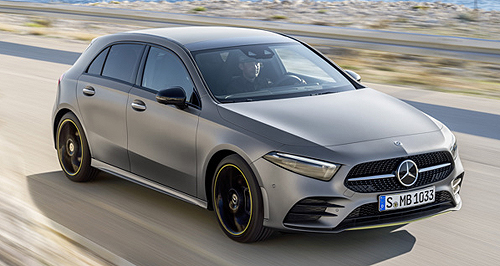News - Mercedes-BenzBenz defends A-Class switch to torsion beam rear endEasy rider: Some variants of the new-generation A-Class will swap the multi-link rear suspension in favour of a simpler torsion beam set-up. Comfort the focus for new A-Class as ride concerns of old addressed, says Mercedes7 Feb 2018 By DANIEL DeGASPERI in AMSTERDAM MERCEDES-BENZ A-Class program manager Oliver Zolke has defended the decision to ditch the multi-link independent rear suspension (IRS) of the outgoing model for a simpler torsion beam axle in some models, insisting that a comfort level befitting of the car-maker was achieved with the new geometry. While the middle-tier 165kW 2.0-litre turbocharged four-cylinder A250 model grade, those above it, and every A-Class with all-wheel drive – dubbed 4Matic – retain IRS, the 120kW 1.4-litre turbo A200 (and the Europe-only 85kW 1.5-litre turbo-diesel A180d) scores a torsion beam rear end that saves 7kg overall. Mr Zolke listed three areas of “weakness” of the outgoing W176 A-Class launched globally in 2012, one of which included all-round visibility – improved by 10 per cent with the new W177– and the others being ride comfort and cabin quietness, and each of which he said have been improved even with the basic new rear end. “The predecessor was clearly on the sporty side, when you drive this car you will see it’s as sporty as the predecessor but at the same time much more comfortable,” he told GoAuto at the global reveal of the new A-Class in Amsterdam this week. “When we start a new development we always check what are the weak points, of course, so we had surround-view (visibility), we had noisy, we had too hard suspension and all those subjects we worked very hard on. “We had the same doubts (about torsion beam), we were really struggling whether to do it and we gave it a chance, and we were very convinced that we have the right system. “When you do a blind-fold test, put two of the same cars on the road and tell me which is the torsion beam and which is the multi-link, I cannot do it. We have a torsion beam axle for Mercedes comfort demands or comfort requirements.” Asked whether a premium-priced small car – at least in Australia – such as the A-Class should retreat to a suspension design often tagged as a cost saver, Mr Zolke replied: “You talk about cost, I talk about weight.”“It was weight reduction and it was also space, you save a lot of space for other components in the rear part. We try to match it to the engines and to the power, and of course to the weight.” In countries with poor road surfacing, however, the program manager agreed that mid-corner irregularities can also prove to be more of a challenge for a single beam axle to handle compared with one with links working on each wheel separately. However he also argued that, “with heavy cars you would feel it (mid-corner bumps) but with lighter cars, this axle I don’t see a big a difference.” Mr Zolke also pointed to the benefits of the second-generation Modular Front-Drive Architecture (MFA-2) platform of the new A-Class as providing a stronger body and mounting points that help reduce stress on suspension components. It meant that a kerb weight reduction of “about 20kg” has been achieved compared with the old A-Class, but “we compensated with crash requirements and higher stiffness and the longer wheelbase” in lieu of major weight savings. “We increased the (body) torsional stiffness, the stiffness of the axle mounting points, and the target was to reduce the rolling noise especially from the rear axle,” he said, adding that IRS-equipped models further get a decoupled subframe design. Specifically, Mercedes-Benz has claimed a 30 per cent increase in powertrain and chassis mounting stiffness compared with the outgoing A-Class, while describing the torsion beam models as having “comfortable tuning” to provide “balanced acoustics.” IRS-equipped models have, however, been described as “performance-type A-Class (that) offers a significant improvement in tyre and road noise.” On both models, the car-maker further claimed wind noise has been reduced by 30 per cent, thanks to increased door sealing and firewall deadening taken from the C-Class – complete with two-layer padding on models with powerful engines. Meanwhile, IRS-equipped models with 4Matic also swap out the former electro-hydraulic pump for the actuation of drive between front and rear axles, for an electro-mechanical clutch said to be quicker acting than before. “It’s a question of response, and we have a quicker response of the whole system,” Mr Zolke said. “The activation of the all-wheel drive is much quicker than before. On the old system you had to have a slight slip to activate the system, and now we have a much quicker (response) and can activate it before it slips. It’s to have a more precise and more active all-wheel drive.” He agreed that there was some criticism of the previous 4Matic system feeling too much like a front-wheel drive vehicle, and although the new unit can still only provide a 50:50 torque split front/rear, the program manager said the Drive Select button can now be used to pro-actively change torque distribution. “The set-up changes on the dynamic mode you drive,” he explained. “So the more sportier the drive mode is, the more rear-wheel drive you have.” But as for a Twinster-style torque vectoring system as seen on the Ford Focus RS, which can make an all-wheel drive vehicle feel decidedly rear-driven?“We don’t have the ability of a Focus RS, not at all,” he admitted. “But I cannot tell you about AMG, it’s part of the Daimler company but not part of our development. They do their own, though we talk from time to time.” The performance A-Class 4Matic versions, the A35 AMG and A45 AMG, will debut later this year and mid-next year respectively (see separate story).  Read more |
Click to shareMercedes-Benz articlesResearch Mercedes-Benz Motor industry news |
















Facebook Twitter Instagram